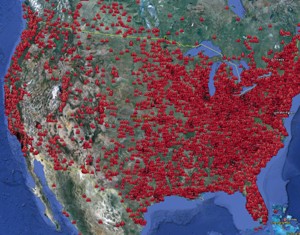Tampa, Orlando, and St. Louis Top the Naughty List for Most Computer Infections in 2014
 Sony executives weren't the only ones getting their computers infected with dangerous malware this year. Hackers and cybercrooks attacked millions of computers across the United States, and people in the cities of Tampa, Orlando, and St. Louis got hit the hardest. We've analyzed more than a quarter million different infections on computers in the 100 largest cities in the U.S. The cities with the most infections per capita were Tampa, Orlando, and St. Louis. Atlanta and Salt Lake City rounded out the top five.
Sony executives weren't the only ones getting their computers infected with dangerous malware this year. Hackers and cybercrooks attacked millions of computers across the United States, and people in the cities of Tampa, Orlando, and St. Louis got hit the hardest. We've analyzed more than a quarter million different infections on computers in the 100 largest cities in the U.S. The cities with the most infections per capita were Tampa, Orlando, and St. Louis. Atlanta and Salt Lake City rounded out the top five.
"It's interesting to see how the infection rate varies from city to city," said Patrick Morganelli, Senior Vice President of Technology at EnigmaSoftware.com. "For example, the infection rate in Tampa was five times that of the average infection rate in the top 100 cities. Orlando was almost four times the average."
What makes one city have higher than normal infection rates? Morganelli says that is very hard to tell. "I wish there was an easy way to determine what makes people in one area more susceptible to malware infections," Morganelli says. "But there are so many different ways that infections can end up on computers that it's tough to make any generalizations about why certain folks in certain cities seem to have more than others."
One of the most common ways malware infections end up on computers is from web sites that contain infected content or that ask users to download files that contain infected content. Many, many times, those are adult web sites. Users are often asked to download updates to their web browser video players so that they can watch adult videos. Instead of downloading an update, the user downloads an infection.
"We're not saying that people in Tampa, Orlando, and St. Louis are visiting more adult web sites than people in other cities," Morganelli says. "But that still is one of the biggest sources of the malware that our software detects."
Where are these malware infections coming from?
The other biggest source of malware infections is when people are tricked into clicking on links that either download malware or take them to a web site that has malware on it. Those links can come in the form of emails that look like something legitimate, or in social media messages that have been hijacked by hackers.
"Because of the growth in online communication--be it Facebook, LinkedIN, Twitter, Pinterest, Instagram--there are now more and more ways for bad guys to reach out to people and trick them into clicking on links," Morganelli said.
Online shopping is another source of infections. People who click on links in emails promising great deals, or people who scour the Internet looking for the best prices can sometimes end up clicking on a link that leads to infection. On each of the last two Cyber Mondays we've noticed infections spiked 40%.
How can you protect your computer from these malware infections?
"The best way to protect yourself is to have a trusted anti-virus and anti-malware program installed and updated regularly. We obviously recommend SpyHunter," said Morganelli. "Then, it's always best to think about that link. Before you click on something in an email or social media message, think for just a couple seconds about whether what you're looking at is too good to be true or seems a little suspicious. Exercising just a little extra caution could help keep you from getting infected."
Below is a list of the top 20 cities with the most infections per capita, along with how much higher their infection rate was compared to the national average.
- Tampa - 561.81% higher than the national average
- Orlando - 386.91% higher than the national average
- St. Louis - 369.37% higher than the national average
- Atlanta - 359.42% higher than the national average
- Salt Lake City - 306.65% higher than the national average
- Denver - 293.11% higher than the national average
- Newark - 260.85% higher than the national average
- Madison, WI - 225.17% higher than the national average
- Cleveland - 215.61% higher than the national average
- Little Rock - 215.61% higher than the national average
- Cincinnati - 182% higher than the national average
- Washington, DC - 169.56% higher than the national average
- Miami 160.38% higher than the national average
- Pittsburgh - 135.49% higher than the national average
- Irvine, CA - 112.07% higher than the national average
- Richmond, VA - 111.91% higher than the national average
- Raleigh, NC - 110.93% higher than the national average
- Minneapolis - 106.04% higher than the national average
- Seattle - 86.05% higher than the national average
- Greensboro, NC - 76.02% higher than the national average